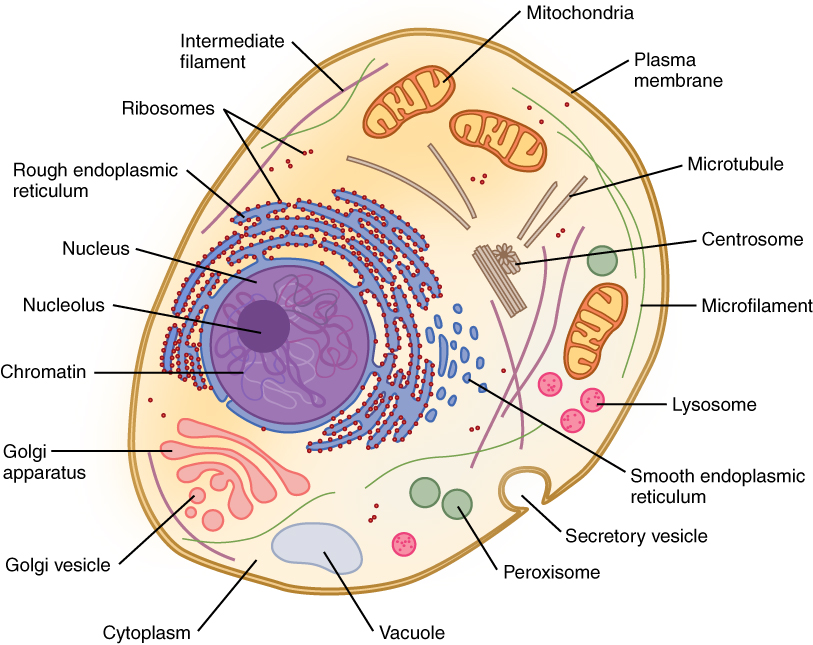
Name the various cell organelles present in the cytoplasm of the cell.
Answer
476.1k+ views
2 likes
Hint: The cellular components which are present in the cell are known as cell organelles. The cell organelles consist of both membranes as well as non-membrane bound organelles that are present in the cell. All the cell organelles differ in their functions and structures.
Complete answer:
There are many organelles present in a cell, and are shown diagrammatically below-

Figure: Cell Organelles
• Plasma membrane- It is the outer protective covering of the entire cell. This layer is made up of lipids and polysaccharides.
• Cytoplasm- The semi-liquid, gel-like structure present in the cell is called cytoplasm. This constitutes the nucleus along with all the organelles.
• Nucleus- It is a double-membrane organelle present in all the eukaryotic cells. Chromosomes are present inside the nucleus. It consists of nucleoplasm, nucleolus, nuclear envelope, and nuclear pore.
• Endoplasmic reticulum- It is a network of fluid-filled membranous canals which work as a transport system in the cell. They are of two types namely rough endoplasmic reticulum, and smooth endoplasmic reticulum.
• Mitochondria- It is a double- membranous structure and popularly known as the powerhouse of the cell.
• Plastids- It is a membrane-bound organelle that consists of pigments. They are broadly divided into chloroplasts, chromoplasts, and leucoplasts.
• Ribosomes- It is a non- membranous organelle. It is found in close association with the endoplasmic reticulum.
• Golgi Apparatus- This organelle comprises stacked, flattened pouches known as cisternae. It is a membrane-bound organelle.
• Vacuoles- It is a membrane-bound organelle. It is mainly present in the plant cell and helps in giving shape and rigidity to the cell. Along with that it also helps in food storage.
• Cilia and flagella- the movement of a cell could take place with the presence of cilia and flagella. Generally, flagella are either one or two in number present in the cell. On the other hand, cilia are more in number and are shorter in size.
Note: The plant and animal cells differ from each other based on cell organelles present in them. The cell wall is present in a plant cell to provide rigidity to the plant and is absent in the animal cell. Cilia is absent in plant cells but is present in unicellular animal cells. The vacuoles are fewer but larger in number in the plants, but in animals, they are smaller but more in number.
Complete answer:
There are many organelles present in a cell, and are shown diagrammatically below-

Figure: Cell Organelles
• Plasma membrane- It is the outer protective covering of the entire cell. This layer is made up of lipids and polysaccharides.
• Cytoplasm- The semi-liquid, gel-like structure present in the cell is called cytoplasm. This constitutes the nucleus along with all the organelles.
• Nucleus- It is a double-membrane organelle present in all the eukaryotic cells. Chromosomes are present inside the nucleus. It consists of nucleoplasm, nucleolus, nuclear envelope, and nuclear pore.
• Endoplasmic reticulum- It is a network of fluid-filled membranous canals which work as a transport system in the cell. They are of two types namely rough endoplasmic reticulum, and smooth endoplasmic reticulum.
• Mitochondria- It is a double- membranous structure and popularly known as the powerhouse of the cell.
• Plastids- It is a membrane-bound organelle that consists of pigments. They are broadly divided into chloroplasts, chromoplasts, and leucoplasts.
• Ribosomes- It is a non- membranous organelle. It is found in close association with the endoplasmic reticulum.
• Golgi Apparatus- This organelle comprises stacked, flattened pouches known as cisternae. It is a membrane-bound organelle.
• Vacuoles- It is a membrane-bound organelle. It is mainly present in the plant cell and helps in giving shape and rigidity to the cell. Along with that it also helps in food storage.
• Cilia and flagella- the movement of a cell could take place with the presence of cilia and flagella. Generally, flagella are either one or two in number present in the cell. On the other hand, cilia are more in number and are shorter in size.
Note: The plant and animal cells differ from each other based on cell organelles present in them. The cell wall is present in a plant cell to provide rigidity to the plant and is absent in the animal cell. Cilia is absent in plant cells but is present in unicellular animal cells. The vacuoles are fewer but larger in number in the plants, but in animals, they are smaller but more in number.
Recently Updated Pages
Master Class 4 Maths: Engaging Questions & Answers for Success

Master Class 4 English: Engaging Questions & Answers for Success

Master Class 4 Science: Engaging Questions & Answers for Success

Class 4 Question and Answer - Your Ultimate Solutions Guide

Master Class 11 Economics: Engaging Questions & Answers for Success

Master Class 11 Business Studies: Engaging Questions & Answers for Success

Trending doubts
In Indian rupees 1 trillion is equal to how many c class 8 maths CBSE

List some examples of Rabi and Kharif crops class 8 biology CBSE

How many ounces are in 500 mL class 8 maths CBSE

Summary of the poem Where the Mind is Without Fear class 8 english CBSE

Give me the opposite gender of Duck class 8 english CBSE

Advantages and disadvantages of science




